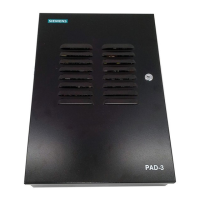16
2.5.7 AC Fail Relay
AC Fail Relay provides a normally open (N.O.) Form “A” contact which will be de-energized without delay
if AC is low or lost. It provides a local signal (audible and visual) of AC fail at the protected premises but
will not cause the DACT to signal.
3+
1+
3-
1-
4+
2+
4-
2-
TB13
TB12
1
2
3
4
5
6
9
10
11
12
13
14
Input 1
EOL 24K
½W 5%
P/N 140-820405
Input 2
Trouble
Relay
NAC
7
8
AC Fail
1+
1-
2+
2-
TB3
FS-250
LOOP CKT
*
EOL
3.6K, 1/4W
P/N 140-830185,
or
470 OHMS, 1/4W
P/N 140-820164,
as applicable
*
EOL
1
2
3
4
5
HTRI-S
#1
1
2
3
4
5
HTRI-S
#2
PAD-3
*
EOL
FS-DLC LOOP
NOTES:
1. Program HTRI-S #1 as Status causing, which will not cause the DACT
to signal but will cause local visual and audible signal. It provides a local
signaling of AC fail at the protected premises.
2. Program HTRI-S #2 as Trouble causing, which will cause the DACT to
signal for all common troubles (including AC fail with reporting delay).
Figure 2-12. AC Fail Relay Connection Example
2.6 Ground Fault Detection Enable/Disable
For some applications (when used with RSA-Series annunciators, for instance), the PAD-3 is used to
provide power to an auxiliary device which gets a control signal from a fire alarm panel. The ground fault
reference for the PAD-3 may be different than the reference used by the fire alarm panel, resulting in a
ground fault trouble at the panel even when none exists. To remedy this condition, the PAD-3 can have
its ground fault detection circuit disabled. Once disabled, the fire alarm panel’s ground fault detection
circuitry will detect any ground fault in the system. See Section 5-2 for correct positioning of this jumper,
and see Figure 2-2 for the location of this jumper.

